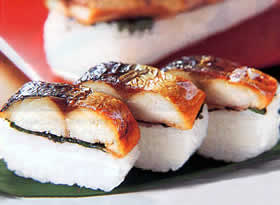| The Story of Sushi |
| http://www.sina.com.cn 2003/08/19 14:03 空中美语 |
语音讲解: 课文朗读:
It took centuries of Japanese innovation to turn Asia’s staple foods—rice and fish—into Japan’s national cuisine. Prior to the days of refrigerators and sushi bars, fresh fish were wrapped in cooked rice and pressed between rocks insgroupsto ferment them. This process preserved the fish, but required many months and made the rice wrappings inedible. Long waits and wasted rice were unacceptable to the Japanese, who began wrapping their fish in vinegar-soaked rice. Adding vinegar improved flavor and greatly reduced the time needed for fermentation. Best of all, the new process didn’t spoil the rice wrappings, which meant they could be eaten with the fish: Sushi was born! |
| 视觉、思想和创意的盛宴:寿司物语 |
在一家日式寿司店里,一列长长的餐盘小火车从顾客眼前驶过。高雅而生动的排列方式是视觉上的一大盛宴,正如寿司赋予味蕾愉悦的口感一样。在品尝各式有创意的海鲜料理的同时,顾客们也许想知道:这样的美食是怎么来的。 日本人花了数百年才将亚洲人的主食──米饭跟鱼──改革成具有日本民族特色的美食。在冰箱与寿司店问世前,人们将新鲜的鱼肉包在煮好的米饭中、压在石头堆里,以使鱼肉发酵。这样加工保存了鱼肉的鲜度,但得花费好几个月的时间,而且使得包在外层的米饭无法食用。 由于日本人受不了长时间的等待和浪费米饭,他们开始用泡过醋的米饭包裹鱼肉。加入醋汁不仅能提味,还可以大大减少发酵所需的时间。最重要的是,新方法令包在外层的米饭不会变质,这表示米饭和鱼肉可以一起食用:寿司就这样诞生了! |
| 【英语学习论坛】【评论】【大 中 小】【打印】【关闭】 |
 Inside a Japanese sushi bar, a long
train of plates passes before the eyes of customers. The elegant and colorful
arrangements are a feast for the eyes, just as the sushi is a delight to the
taste buds. While enjoying the wide variety of seafood creations, customers
may wonder how this delicious treat ever came to be.
Inside a Japanese sushi bar, a long
train of plates passes before the eyes of customers. The elegant and colorful
arrangements are a feast for the eyes, just as the sushi is a delight to the
taste buds. While enjoying the wide variety of seafood creations, customers
may wonder how this delicious treat ever came to be.